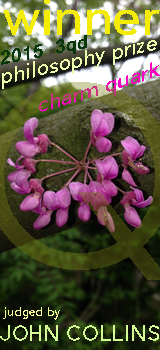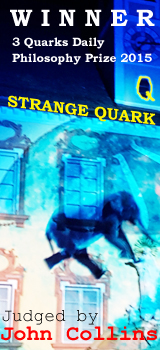


John Collins has picked the three winners from the nine finalists:
- Top Quark, $500: Vidar Halgunset, Slow Corruption
- Strange Quark, $200: Daniel Silvermint, On How We Talk About Passing
- Charm Quark, $100: Lisa Herzog, (One of) Effective Altruism’s blind spot(s)
Here is what Professor Collins has to say about the winners:
The nine finalists for this year’s 3QD Philosophy Prize are all very fine examples of philosophical blogging. They combine clarity, immediacy, subtlety, humanity, and provocation. The task of judging them was a difficult pleasure. I learned something from every single one of these posts and I would be hard pressed indeed to explain, in any detail, my reasons for having excluded each of the other six pieces from the group to be awarded quark flavor.
After an initial read-through on December 17th, four of the entries stood out to me. On a second reading of the whole field a week later I found that I had narrowed the selection down to three of those four. But then I became stuck. It took a third and fourth reading and some agonizing, before I began to feel at all confident about a final ranking.
In 3rd Place, the Charm Quark goes to Lisa Herzog for her piece on the Justice Everywhere blog: “(One of) Effective Altruism’s Blind Spot(s) …”.
Moral theories that prescribe extreme versions of utilitarianism are sometimes criticized for being too demanding. Herzog’s focus is on a respect in which effective altruism appears to be not demanding enough.
By taking existing social institutions and practices as simply given the effective altruist finds herself choosing from a “restaurant menu” of given options, ignoring the possibility of deeper structural change. When the problem is construed as one of individual choice rather than collective action, such approaches will remain invisible.
The Strange Quark for 2nd Place is awarded to Daniel Silvermint for a sensitive and nuanced essay on the Feminist Philosophers blog: “On How We Talk About Passing”.
Silvermint’s piece, occasioned by last summer’s Rachel Dolezal incident, avoids the thorny issue of why, exactly, self-identification might be taken to be authoritative in the case of gender though not race, and asks us instead to hesitate and reconsider what we are doing when we rush to police the trespass of socially constructed categories that are tracked by highly unreliable markers. There is a valuable discussion here of the varieties of passing, though I found myself unsure as to whether to accept Silvermint’s suggestion that we apply the concept even to cases where there is neither misidentification nor intent. Can, for example, a white cisgender man, who, through privilege has had the luxury of never giving these matters a moment’s thought, really be said to be “passing” as white and male? Silvermint comments that “a trans woman that passes isn’t a man pretending to be a woman – she is a woman”. I agree wholeheartedly with the main point there, but I’d be inclined to add that her being a woman means that she isn’t simply passing as a woman either. (Whether a trans person might be said to—or want to?—pass as cisgender is another matter.)
My choices for the top two spots share this quality: they warn us to slow down, hesitate, and carefully reconsider the rush to judgment that is often encouraged by quick-fire debate in social media and in online discussion in general.
In first place, the winner of the 3QD Top Quark for philosophical blogging in 2015 is Vidar Halgunset for his piece on the Orienteringsforsøk blog: “Slow Corruption”.
I liked the simple humanity of this essay very much. Halgunset’s immediate topic is the recent public debate in Norway over the selective abortion of fetuses diagnosed with Down’s syndrome. His central suggestion is that we focus not on the question “what would be so terrible about a society without Down’s syndrome?” but ask instead, why might it be undesirable to create a society that lacked people with Down’s syndrome? And he asks us to stop and consider the reception of this debate by those of us who have Down’s syndrome.
But there’s another subtle thread woven through this piece, that has to do with what we ought to debate publicly, and how we ought to discuss it. Halgunset begins by quoting a particularly insensitive tweet of Richard Dawkins’s and asks us to consider whether the distinction between tone and content in this message is really as clear as Dawkins would maintain. The slow corrupting influence here is that of the public expression of blind certainty in 140 characters or fewer. These are matters of tone and selective silence. I am reminded of a comment my late friend and colleague Sid Morgenbesser once made to me: “Don’t you think there are situations in which it is simply indecent to deliberate at all?”
Orienteringsforsøk, we’re told, is written at 78.13 degrees of latitude North (Longyearbyen?). It’s a safe bet, I think, that this is indeed “the Northernmost Philosophy Blog in the World”.
From here this late December summer morning, writing these words at 33.87 degrees South, I send a heart-felt “Godt Nytt År!” to the distant Svalbard Archipelago. There’s reason here, I think, to be optimistic about the incoming year 2016.
John Collins, December 27th, 2015, Sydney
Congratulations also from 3QD to the winners (remember, you must claim the money within one month from today—just send me an email). And feel free, in fact we encourage you, to leave your acceptance speech as a comment here! And thanks to everyone who participated. Many thanks also, of course, to John Collins for doing the final judging.
The three prize logos at the top of this post were designed by me, Sughra Raza, and Margit Oberrauch. I hope the winners will display them with pride on their own blogs!
Details about the prize here.
George Walden at the Times Literary Supplement:

